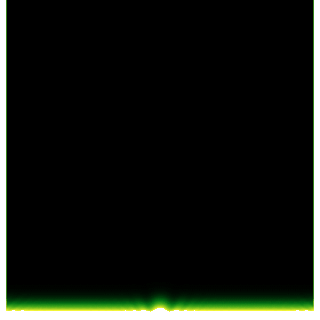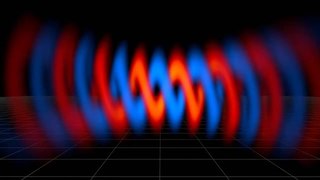Related Research Articles

Optical tweezers are scientific instruments that use a highly focused laser beam to hold and move microscopic and sub-microscopic objects like atoms, nanoparticles and droplets, in a manner similar to tweezers. If the object is held in air or vacuum without additional support, it can be called optical levitation.
Super-resolution imaging (SR) is a class of techniques that enhance (increase) the resolution of an imaging system. In optical SR the diffraction limit of systems is transcended, while in geometrical SR the resolution of digital imaging sensors is enhanced.
Planar chirality, also known as 2D chirality, is the special case of chirality for two dimensions.
A superlens, or super lens, is a lens which uses metamaterials to go beyond the diffraction limit. The diffraction limit is a feature of conventional lenses and microscopes that limits the fineness of their resolution depending on the illumination wavelength and the numerical aperture (NA) of the objective lens. Many lens designs have been proposed that go beyond the diffraction limit in some way, but constraints and obstacles face each of them.
In quantum mechanics, a quantum eraser experiment is an interferometer experiment that demonstrates several fundamental aspects of quantum mechanics, including quantum entanglement and complementarity. The quantum eraser experiment is a variation of Thomas Young's classic double-slit experiment. It establishes that when action is taken to determine which of 2 slits a photon has passed through, the photon cannot interfere with itself. When a stream of photons is marked in this way, then the interference fringes characteristic of the Young experiment will not be seen. The experiment also creates situations in which a photon that has been "marked" to reveal through which slit it has passed can later be "unmarked." A photon that has been "unmarked" will interfere with itself once again, restoring the fringes characteristic of Young's experiment.
Contact lithography, also known as contact printing, is a form of photolithography whereby the image to be printed is obtained by illumination of a photomask in direct contact with a substrate coated with an imaging photoresist layer.
Atom optics "refers to techniques to manipulate the trajectories and exploit the wave properties of neutral atoms". Typical experiments employ beams of cold, slowly moving neutral atoms, as a special case of a particle beam. Like an optical beam, the atomic beam may exhibit diffraction and interference, and can be focused with a Fresnel zone plate or a concave atomic mirror.
Raymond Eldred Siday (1912–1956) was an English mathematician specialising in quantum mechanics. He obtained his BSc in Special Physics and later worked at the University of Edinburgh. He began collaborating with Werner Ehrenberg in 1933.

A Bessel beam is a wave whose amplitude is described by a Bessel function of the first kind. Electromagnetic, acoustic, gravitational, and matter waves can all be in the form of Bessel beams. A true Bessel beam is non-diffractive. This means that as it propagates, it does not diffract and spread out; this is in contrast to the usual behavior of light, which spreads out after being focused down to a small spot. Bessel beams are also self-healing, meaning that the beam can be partially obstructed at one point, but will re-form at a point further down the beam axis.

A METATOY is a sheet, formed by a two-dimensional array of small, telescopic optical components, that switches the path of transmitted light rays. METATOY is an acronym for "metamaterial for rays", representing a number of analogies with metamaterials; METATOYs even satisfy a few definitions of metamaterials, but are certainly not metamaterials in the usual sense. When seen from a distance, the view through each individual telescopic optical component acts as one pixel of the view through the METATOY as a whole. In the simplest case, the individual optical components are all identical; the METATOY then behaves like a homogeneous, but pixellated, window that can have very unusual optical properties.

The term chiral describes an object, especially a molecule, which has or produces a non-superposable mirror image of itself. In chemistry, such a molecule is called an enantiomer or is said to exhibit chirality or enantiomerism. The term "chiral" comes from the Greek word for the human hand, which itself exhibits such non-superimposeability of the left hand precisely over the right. Due to the opposition of the fingers and thumbs, no matter how the two hands are oriented, it is impossible for both hands to exactly coincide. Helices, chiral characteristics (properties), chiral media, order, and symmetry all relate to the concept of left- and right-handedness.
Super-resolution microscopy is a series of techniques in optical microscopy that allow such images to have resolutions higher than those imposed by the diffraction limit, which is due to the diffraction of light. Super-resolution imaging techniques rely on the near-field or on the far-field. Among techniques that rely on the latter are those that improve the resolution only modestly beyond the diffraction-limit, such as confocal microscopy with closed pinhole or aided by computational methods such as deconvolution or detector-based pixel reassignment, the 4Pi microscope, and structured-illumination microscopy technologies such as SIM and SMI.

Transformation optics is a branch of optics which applies metamaterials to produce spatial variations, derived from coordinate transformations, which can direct chosen bandwidths of electromagnetic radiation. This can allow for the construction of new composite artificial devices, which probably could not exist without metamaterials and coordinate transformation. Computing power that became available in the late 1990s enables prescribed quantitative values for the permittivity and permeability, the constitutive parameters, which produce localized spatial variations. The aggregate value of all the constitutive parameters produces an effective value, which yields the intended or desired results.

A coherent perfect absorber (CPA), or anti-laser, is a device which absorbs coherent waves, such as coherent light waves, and converts them into some form of internal energy, e.g. heat or electrical energy. It is the time-reversed counterpart of a laser. Coherent perfect absorption allows control of waves with waves without a nonlinear medium. The concept was first published in the July 26, 2010, issue of Physical Review Letters, by a team at Yale University led by theorist A. Douglas Stone and experimental physicist Hui W. Cao. In the September 9, 2010, issue of Physical Review A, Stefano Longhi of Polytechnic University of Milan showed how to combine a laser and an anti-laser in a single device. In February 2011 the team at Yale built the first working anti-laser. It is a two-channel CPA device which absorbs two beams from the same laser, but only when the beams have the correct phases and amplitudes. The initial device absorbed 99.4 percent of all incoming light, but the team behind the invention believe it will be possible to achieve 99.999 percent. Originally implemented as a Fabry-Pérot cavity that is many wavelengths thick, the optical CPA operates at specific optical frequencies. In January 2012, thin-film CPA has been proposed by utilizing the achromatic dispersion of metal-like materials, exhibiting the unparalleled bandwidth and thin profile advantages. Shortly after, CPA was observed in various thin film materials, including photonic metamaterial, multi-layer graphene, single and multiple layers of chromium, as well as microwave metamaterial.

The orbital angular momentum of light (OAM) is the component of angular momentum of a light beam that is dependent on the field spatial distribution, and not on the polarization. OAM can be split into two types. The internal OAM is an origin-independent angular momentum of a light beam that can be associated with a helical or twisted wavefront. The external OAM is the origin-dependent angular momentum that can be obtained as cross product of the light beam position and its total linear momentum.
The two-state vector formalism (TSVF) is a description of quantum mechanics in terms of a causal relation in which the present is caused by quantum states of the past and of the future taken in combination.

An electromagnetic metasurface refers to a kind of artificial sheet material with sub-wavelength thickness. Metasurfaces can be either structured or unstructured with subwavelength-scaled patterns in the horizontal dimensions.

Sergei Anatolyevich Tretyakov is a Russian-Finnish scientist, focused in electromagnetic field theory, complex media electromagnetics and microwave engineering. He is currently a professor at Department of Electronics and Nanoengineering, Aalto University, Finland. His main research area in recent years is metamaterials and metasurfaces from fundamentals to applications. He was the president of the European Virtual Institute for Artificial Electromagnetic Materials and Metamaterials and general chair of the Metamaterials Congresses from 2007 to 2013. He is a fellow/member of many scientific associations such as IEEE, URSI, the Electromagnetics Academy, and OSA. He is also an Honorary Doctor of Francisk Skorina Gomel State University.

Igor V. Minin, is a Russian physicist, corresponding member of the Russian Academy of Metrology, and a full professor of Physics at the Tomsk Polytechnic University. He became known for his contribution to the creation of new directions in science: THz 3D Zone plate, Mesotronics, and subwavelength structured light, including acoustics and surface plasmon.
Mark Stockman was a Soviet-born American physicist. He was a professor of physics and astronomy at Georgia State University. Best known for his contributions to plasmonics, Stockman has co-theorized plasmonic lasers, also known as spasers, in 2003.
References
- ↑ Berry, M V, 1994, 'Faster than Fourier', in 'Quantum Coherence and Reality; in celebration of the 60th Birthday of Yakir Aharonov' (J S Anandan and J L Safko, eds.) World Scientific, Singapore, pp 55-65.
- ↑ Berry, M. V.; Dennis, M. R. (2009). "Natural superoscillations in monochromatic waves in Ddimensions". Journal of Physics A: Mathematical and Theoretical. 42 (2): 022003. doi:10.1088/1751-8113/42/2/022003. S2CID 120985111.
- ↑ Huang, Fu Min; Zheludev, Nikolay; Chen, Yifang; Javier Garcia De Abajo, F. (2007). "Focusing of light by a nanohole array". Applied Physics Letters. 90 (9): 091119. arXiv: physics/0611056 . Bibcode:2007ApPhL..90i1119H. doi:10.1063/1.2710775. S2CID 10434523.
- ↑ Huang, Fu Min; Chen, Yifang; Garcia De Abajo, F Javier; Zheludev, Nikolay I. (2007). "Optical super-resolution through super-oscillations" (PDF). Journal of Optics A: Pure and Applied Optics. 9 (9): S285–S288. doi:10.1088/1464-4258/9/9/S01.
- ↑ Huang, Fu Min; Zheludev, Nikolay I. (2009). "Super-Resolution without Evanescent Waves". Nano Letters. 9 (3): 1249–1254. arXiv: 0812.0508 . Bibcode:2009NanoL...9.1249H. doi:10.1021/nl9002014. PMID 19182908. S2CID 14091064.
- ↑ Kempf, Achim (2000). "Black holes, bandwidths and Beethoven". Journal of Mathematical Physics. 41 (4): 2360–2374. arXiv: gr-qc/9907084 . Bibcode:2000JMP....41.2360K. doi:10.1063/1.533244. S2CID 14858993.
- ↑ Chremmos, Ioannis; Fikioris, George (2015). "Superoscillations with arbitrary polynomial shape". Journal of Physics A: Mathematical and Theoretical. 48 (26): 265204. arXiv: 1504.04822 . Bibcode:2015JPhA...48z5204C. doi:10.1088/1751-8113/48/26/265204. S2CID 119137509.
- ↑ Greenfield, Elad; Schley, Ran; Hurwitz, Ilan; Nemirovsky, Jonathan; Makris, Konstantinos G.; Segev, Mordechai (2013). "Experimental generation of arbitrarily shaped diffractionless superoscillatory optical beams". Optics Express. 21 (11): 13425–13435. Bibcode:2013OExpr..2113425G. doi: 10.1364/oe.21.013425 . PMID 23736595. S2CID 31157421.
- ↑ David, Asaf; Gjonaj, Bergin; Blau, Yochai; Dolev, Shimon; Bartal, Guy (2015). "Nanoscale shaping and focusing of visible light in planar metal–oxide–silicon waveguides". Optica. 2 (12): 1045–1048. Bibcode:2015Optic...2.1045D. doi: 10.1364/OPTICA.2.001045 .
- ↑ Ferreira, P.J.S.G.; Kempf, A. (2006). "Superoscillations: Faster Than the Nyquist Rate" (PDF). IEEE Transactions on Signal Processing. 54 (10): 3732–3740. Bibcode:2006ITSP...54.3732F. doi:10.1109/TSP.2006.877642. S2CID 17467946.
- ↑ Thomson, Laura C.; Boissel, Yannick; Whyte, Graeme; Yao, Eric; Courtial, Johannes (2008). "Simulation of superresolution holography for optical tweezers" (PDF). New Journal of Physics. 10 (2): 023015. Bibcode:2008NJPh...10b3015T. doi: 10.1088/1367-2630/10/2/023015 .
- ↑ Zheludev, Nikolay I. (2008). "What diffraction limit?". Nature Materials. 7 (6): 420–422. Bibcode:2008NatMa...7..420Z. doi:10.1038/nmat2163. PMID 18497841. S2CID 30418364.